Danube River: Hydrological Features and Risk Assessment with a Focus on Navigation and Monitoring Frameworks
Abstract
1. Introduction
2. Characteristics of the Danube
3. Navigability and Economic Contribution
4. Hydrological Risks and Challenges on the Danube
4.1. Floods
4.2. Droughts
5. Institutions for Monitoring and Management of the Danube
6. Methods, Technologies, and Software Used in Hydrological Studies
6.1. Methods and Software Used in Hydrological Studies
6.2. Hydrometric Station Network and Technologies
7. Future Perspectives and Specific Recommendations
- The monitoring infrastructure should be improved by installing the latest generation of sensors in hydrometric stations to allow real-time data transmission.
- Create an integrated transboundary open-access cross-border data platform to facilitate research, analysis, and rapid decision-making.
- Promote applied research in artificial intelligence, remote sensing, and hydrological scenario simulation.
- Foster collaboration between countries through participatory governance mechanisms involving central authorities and local communities.
8. Conclusions
Author Contributions
Funding
Data Availability Statement
Acknowledgments
Conflicts of Interest
Abbreviations
| ADCP | Acoustic Doppler Current Profiler |
| AI | Artificial Intelligence |
| ArcGIS | Arc Geographic Information System |
| DEF | Danube Environmental Forum |
| DFRMP | Danube Flood Risk Management Plan |
| DMCSEE | Drought Management Centre for Southeastern Europe |
| DriDanube | Drought Risk in the Danube Region |
| DSTF | Danube Sturgeon Task Force |
| DUS | Danube Drought User Service |
| EDO | European Drought Observatory |
| EEA | European Environment Agency |
| EU | Europe Union |
| EUMETSAT | European Organisation for the Exploitation of Meteorological Satellites |
| EUSDR | EU Strategy for the Danube Region |
| GIS | Geographic Information System |
| GPR | Ground-Penetrating Radar |
| GPRS | General Packet Radio Service |
| GPRSIM | Ground Penetrating Radar Simulation Software |
| GRDC | Global Runoff Data Centre |
| GSM | Global System for Mobile Communications |
| HEC-HMS | Hydrologic Engineering Center—Hydrologic Modeling System |
| HEC-RAS | Hydrologic Engineering Center—River Analysis System |
| HYPE | Hydrological Predictions for the Environment |
| ICPDR | International Commission for the Protection of the Danube River |
| IoT sensor | Internet of Things sensor |
| LiDAR | Light Detection and Ranging |
| LSTM | Long Short-Term Memory |
| MODIS | Moderate Resolution Imaging Spectroradiometer |
| NGOs | Non-governmental organizations |
| pH | Potential of hydrogen |
| RNA | Romanian Naval Authority |
| TRMM | Tropical Rainfall Measuring Mission |
| SWAT | The Soil and Water Assessment Tool |
| SWOT | Strengths, Weaknesses, Opportunities, and Threats |
| UHF | Ultra High Frequency |
| UN | United Nations |
| UNESCO | United Nations Educational, Scientific and Cultural Organization |
| VHF | Very High Frequency |
| WMO | World Meteorological Organization |
| 4G | Fourth Generation of Mobile Network Technology |
References
- Bowen, A.; Cochrane, S.; Fankhauser, S. Climate change, adaptation and economic growth. Clim. Change 2012, 113, 95–106. [Google Scholar] [CrossRef]
- Samuel, H.; Joel, S. Estimating global impacts from climate change. Glob. Environ. Change 2004, 14, 201–218. [Google Scholar] [CrossRef]
- Calzadilla, A.; Rehdanz, K.; Betts, R.; Falloon, P.; Wiltshire, A.; Tol, R.S.J. Climate change impacts on global agriculture. Clim. Change 2023, 120, 357–374. [Google Scholar] [CrossRef]
- Richard, S.J.; Thomas, E.D.; Onno, J.K.; Joel, B.S. Distributional aspects of climate change impacts. Glob. Environ. Change 2004, 14, 259–272. [Google Scholar] [CrossRef]
- Bibi, F.; Rahman, A. An Overview of Climate Change Impacts on Agriculture and Their Mitigation Strategies. Agriculture 2023, 13, 1508. [Google Scholar] [CrossRef]
- Balica, S.F.; Wright, N.G.; Van der Meulen, F. A flood vulnerability index for coastal cities and its use in assessing climate change impacts. Nat. Hazards 2012, 64, 73–105. [Google Scholar] [CrossRef]
- Dey, R.; Lewis, S.C. Chapter 6—Natural disasters linked to climate change. In The Impacts of Climate Change; Letcher, T.M., Ed.; Elsevier: Amsterdam, The Netherlands, 2021; pp. 177–193. [Google Scholar] [CrossRef]
- Brázdil, R.; Kundzewicz, Z.W.; Benito, G.; Demarée, G.; Macdonald, N.; Roald, L.A. Historical floods in Europe in the past millennium. In Changes in Flood Risk in Europe; Kundzewicz, Z.W., Ed.; IAHS Special Publication; IAHS Press: Wallingford, UK, 2012; Volume 10, pp. 121–166. [Google Scholar] [CrossRef]
- Chiroşca, A.-M.; Rusu, L. Study on Navigation Conditions and Shipping Traffic on the Danube in the Period 2010–2020. J. Danub. Stud. Res. 2021, 11, 192–201. [Google Scholar]
- Stagl, J.C.; Hattermann, F.F. Impacts of Climate Change on Riverine Ecosystems: Alterations of Ecologically Relevant Flow Dynamics in the Danube River and Its Major Tributaries. Water 2016, 8, 566. [Google Scholar] [CrossRef]
- Kling, H.; Fuchs, M.; Paulin, M. Runoff conditions in the upper Danube basin under an ensemble of climate change scenarios. J. Hydrol. 2012, 424–425, 264–277. [Google Scholar] [CrossRef]
- Stanzel, P.; Kling, H. From ENSEMBLES to CORDEX: Evolving climate change projections for Upper Danube River flow. J. Hydrol. 2018, 563, 987–999. [Google Scholar] [CrossRef]
- Mikhailova, M.V.; Mikhailov, V.N.; Morozov, V.N. Extreme hydrological events in the Danube River basin over the last decades. Water Resour. 2012, 39, 161–179. [Google Scholar] [CrossRef]
- Sommerwerk, N.; Bloesch, J.; Baumgartner, C.; Bittl, T.; Čerba, D.; Csányi, B.; Davideanu, G.; Dokulil, M.; Frank, G.; Grecu, I. Chapter 3—The Danube River Basin. In Rivers of Europe, 2nd ed.; Tockner, K., Zarfl, C., Robinson, C.T., Eds.; Elsevier: Amsterdam, The Netherlands, 2022; pp. 81–180. [Google Scholar] [CrossRef]
- Ebert, S.; Hulea, O.; Strobel, D. Floodplain restoration along the lower Danube: A climate change adaptation case study. Clim. Dev. 2009, 1, 212–219. [Google Scholar] [CrossRef]
- Arseni, M.; Rosu, A.; Calmuc, M.; Calmuc, V.A.; Iticescu, C.; Georgescu, L.P. Development of Flood Risk and Hazard Maps for the Lower Course of the Siret River, Romania. Sustainability 2020, 12, 6588. [Google Scholar] [CrossRef]
- Georgescu, L.P.; Ionescu, R.V.; Antohi, V.M.; Zlati, M.L.; Iticescu, C. A New Model for Quantifying the Impact of the Social Economy on the Sustainability of Water Resources. Water 2025, 17, 561. [Google Scholar] [CrossRef]
- Grigorescu, L. The Strategic Importance of the Danube in the Context of a Future Romanian Maritime Security Strategy for the Black Sea. Rom. Mil. Think. 2023, 2, 96–115. Available online: https://www.ceeol.com/search/article-detail?id=1211151 (accessed on 17 February 2025). [CrossRef]
- Chirosca, A.M.; Vazdoaga, I.; Popa, V.I.; Rusu, L. The economic importance of navigation along the Danube-Black Sea channel. Int. Multidiscip. Sci. GeoConference SGEM 2021, 21, 297–305. [Google Scholar] [CrossRef]
- Gasparotti, C.; Modiga, A.; Domnisoru, L.; Rusu, E. The recent dynamics of the navigation and main harbour operations in the area of the maritime Danube. In Proceedings of the International Conference on Traffic and Transport Engineering, Belgrade, Serbia, 24–25 November 2016; pp. 242–249. [Google Scholar]
- Jászberényi, M.; Miskolczi, M. Danube cruise tourism as a niche product—An overview of the current supply and potential. Sustainability 2020, 12, 4598. [Google Scholar] [CrossRef]
- Lukić, D.; Berjan, S.; El Bilali, H. Indicators of tourism development of the Serbian Danube region. R-Economy 2018, 4, 30–37. [Google Scholar] [CrossRef]
- Chiripuci, B.-C.; Constantin, M.; Popescu, M.-F.; Scrieciu, A. The Socio-Economic Impact of Migration on the Labor Market in the Romanian Danube Region. Sustainability 2020, 12, 8654. [Google Scholar] [CrossRef]
- Bănăduc, D.; Rey, S.; Trichkova, T.; Lenhardt, M.; Curtean-Bănăduc, A. The Lower Danube River–Danube Delta–North West Black Sea: A pivotal area of major interest for the past, present and future of its fish fauna—A short review. Sci. Total Environ. 2016, 545, 137–151. [Google Scholar] [CrossRef]
- Dogaru, D.; Mauser, W.; Balteanu, D.; Krimly, T.; Lippert, C.; Sima, M.; Frank, A. Irrigation water use in the Danube Basin: Facts, governance and approach to sustainability. J. Environ. Geogr. 2019, 12, 1–12. [Google Scholar] [CrossRef]
- Jeločnik, M.; Nastić, L.; Subić, J. Analysis of agriculture and rural development in the upper Danube region-SWOT analysis. In Proceedings of the International Scientific Meeting-Economie Agrara si Dezvoltare Rurala Realitati si Perspective Pentru Romania, Editia a–II–a, Plenary Session. Bucharest, Romania, 8–9 September 2011; pp. 9–15. Available online: https://symposium.iceadr.ro/wp-content/uploads/2023/04/Volum-2011.pdf (accessed on 17 February 2025).
- Smederevac-Lalić, M.; Jarić, I.; Višnjić-Jeftić, Ž.; Skorić, S.; Cvijanović, G.; Gačić, Z.; Lenhardt, M. Management approaches and aquaculture of sturgeons in the Lower Danube region countries. J. Appl. Ichthyol. 2011, 27, 94–100. [Google Scholar] [CrossRef]
- Draganova-Zlateva, I.; Kolev, V.; Dilkov, P. Hydro Energy Use of the Water Potential of The Danube River. In Proceedings of the 14th Electrical Engineering Faculty Conference (BulEF), Varna, Bulgaria, 14–17 September 2022; pp. 1–5. [Google Scholar]
- Huđek, H.; Žganec, K.; Pusch, M.T. A review of hydropower dams in Southeast Europe–distribution, trends and availability of monitoring data using the example of a multinational Danube catchment subarea. Renew. Sustain. Energy Rev. 2020, 117, 109434. [Google Scholar] [CrossRef]
- Wagner, B.; Hauer, C.; Habersack, H. Current hydropower developments in Europe. Curr. Opin. Environ. Sustain. 2019, 37, 41–49. [Google Scholar] [CrossRef]
- Năstase, G.; Şerban, A.; Năstase, A.F.; Dragomir, G.; Brezeanu, A.I.; Iordan, N.F. Hydropower development in Romania. A review from its beginnings to the present. Renew. Sustain. Energy Rev. 2017, 80, 297–312. [Google Scholar] [CrossRef]
- Szépszó, G.; Lingemann, I.; Klein, B.; Kovács, M. Impact of climate change on hydrological conditions of Rhine and Upper Danube rivers based on the results of regional climate and hydrological models. Nat. Hazards 2014, 72, 241–262. [Google Scholar] [CrossRef]
- Răileanu, A.B.; Rusu, L.; Rusu, E. An Evaluation of the Dynamics of Some Meteorological and Hydrological Processes along the Lower Danube. Sustainability 2023, 15, 6087. [Google Scholar] [CrossRef]
- Popa, P.; Murariu, G.; Timofti, M.; Georgescu, L. Multivariate Statistical Analyses of water quality of Danube River at Galati, Romania. Environ. Eng. Manag. J. 2018, 17, 1249–1266. Available online: http://www.eemj.icpm.tuiasi.ro/pdfs/vol17/full/no5/24_290_Popa_14.pdf (accessed on 17 February 2025).
- Radmilović, Z.; Maraš, V. Role of Danube inland navigation in Europe. Int. J. Traffic Transp. Eng. 2011, 1, 28–40. [Google Scholar]
- Chirosca, A.M.; Rusu, L.; Popa, V.I.; Rusu, E. Climate analysis along the navigation routes on the Danube. Int. Multidiscip. Sci. GeoConference SGEM 2024, 3.1, 59–66. [Google Scholar] [CrossRef]
- Berlinsky, N.; Bogatova, Y.; Garkavaya, G. Estuary of the Danube. In Estuaries; Wangersky, P.J., Ed.; The Handbook of Environmental Chemistry; Springer: Berlin/Heidelberg, Germany, 2006; Volume 5H, pp. 233–264. [Google Scholar] [CrossRef]
- Vâzdoagă, I.; Chiroşcă, A.M.; Popa, V.I.; Rusu, L. Extreme phenomena on Danube hydrodynamics and the influence on the navigation conditions. Int. Multidiscip. Sci. GeoConference SGEM 2020, 3.1, 123–130. [Google Scholar] [CrossRef]
- The International Commission for the Protection of the Danube River (ICPDR). Available online: https://www.icpdr.org/danube-basin/danube-river-basin/ (accessed on 24 May 2025).
- Giosan, L.; Donnelly, J.; Vespremeanu, E.; Bhattacharya, J.; Olariu, C.; Buonaiuto, F. River delta morphodynamics: Examples from the Danube Delta. River Deltas Concepts Model Ex. SEPM Spec. Publ. 2005, 83, 393–411. [Google Scholar]
- Tănăsescu, M.; Constantinescu, S. The human ecology of the Danube Delta: A historical and cartographic perspective. J. Environ. Manag. 2020, 262, 110324. [Google Scholar] [CrossRef] [PubMed]
- Stagl, J.C.; Hattermann, F.F. Impacts of Climate Change on the Hydrological Regime of the Danube River and Its Tributaries Using an Ensemble of Climate Scenarios. Water 2015, 7, 6139–6172. [Google Scholar] [CrossRef]
- Ogrinc, N.; Markovics, R.; Kanduč, T.; Walter, L.M.; Hamilton, S.K. Sources and transport of carbon and nitrogen in the River Sava watershed, a major tributary of the River Danube. Appl. Geochem. 2008, 23, 3685–3698. [Google Scholar] [CrossRef]
- Schreiber, H.; Behrendt, H.; Constantinescu, L.T.; Cvitanic, I.; Drumea, D.; Jabucar, D.; Zessner, M. Nutrient emissions from diffuse and point sources into the River Danube and its main tributaries for the period of 1998–2000–results and problems. Water Sci. Technol. 2005, 51, 283–290. [Google Scholar] [CrossRef]
- Petošić, D.; Mustać, I.; Filipović, V.; Stričević, I. Joint impact of the Danube-Sava canal and agriculture upon the existing agroecosystems. In Proceedings of the 46th Croatian and 6th International Symposium on Agriculture, Opatija, Croatia, 14–18 February 2011; pp. 41–50. [Google Scholar]
- Milanović, A.; Milijašević, D.; Brankov, J. Assessment of polluting effects and surface water quality using water pollution index: A case study of Hydro-system Danube-Tisa-Danube, Serbia. Carpathian J. Earth Environ. Sci. 2011, 6, 269–277. [Google Scholar]
- Grabić, J.; Benka, P.; Bezdan, A.; Josimov-Dunđerski, J.; Salvai, A. Water quality management for preserving fish populations within hydro-system Danube-Tisa-Danube, Serbia. Carpathian J. Earth Environ. Sci. 2016, 11, 235–243. [Google Scholar]
- Garnier, J.; Billen, G.; Hannon, E.; Fonbonne, S.; Videnina, Y.; Soulie, M. Modelling the Transfer and Retention of Nutrients in the Drainage Network of the Danube River. Estuar. Coast. Shelf Sci. 2002, 54, 285–308. [Google Scholar] [CrossRef]
- Ionuş, O.; Licurici, M.; Pătroescu, M.; Boengiu, S. Assessment of flood-prone stripes within the Danube drainage area in the South-West Oltenia Development Region, Romania. Nat. Hazards 2015, 75 (Suppl. S1), 69–88. [Google Scholar] [CrossRef]
- Backalic, T.; Maslaric, M. Navigation conditions and the risk management in inland waterway transport on the middle Danube. Transp. Probl. 2012, 7, 13–24. [Google Scholar]
- Pencheva, V.; Asenov, A.; Sładkowski, A.; Georgiev, I.; Beloev, I.; Ivanov, K. The Danube River, Multimodality and Intermodality. In Modelling of the Interaction of the Different Vehicles and Various Transport Modes; Sładkowski, A., Ed.; Lecture Notes in Intelligent Transportation and Infrastructure; Springer: Cham, Switzerland, 2020; pp. 233–288. [Google Scholar] [CrossRef]
- Turnock, D. The Danube-Black Sea Canal and its impact on Southern Romania. GeoJournal 1986, 12, 65–79. [Google Scholar] [CrossRef]
- Šołkic, S.; Đekic, Z.; Kresojevic, M. Analysis of River–Sea Transport in the Direction of the Danube–Black Sea and the Danube Rhine River River Main. In Marine Navigation and Safety of Sea Transportation: Navigational Problems; CRC Press: Boca Raton, FL, USA, 2013; pp. 199–207. [Google Scholar]
- Chirosca, A.M.; Rusu, L. Statistical and economic analysis of the Rhine-Main-Danube Canal, the bridge between the North Sea and the Black Sea. J. Danub. Stud. Res. 2021, 11, 192–201. [Google Scholar]
- Mako, P.; Galieriková, A. Inland navigation on the Danube and the Rhine waterways. Transp. Res. Procedia 2021, 55, 10–17. [Google Scholar] [CrossRef]
- Dávid, A.; Midan, A.A.; Klosak, M.; Douimia, Y. Sustainability of Inland Water Transport on the Rhine-Main-Danube Waterway. In Proceedings of the 3rd Cognitive Mobility Conference. COGMOB 2024; Zöldy, M., Ed.; Lecture Notes in Networks and Systems; Springer: Cham, Switzerland, 2025; Volume 1258. [Google Scholar] [CrossRef]
- Olson, K.R.; Krug, E. The Danube, an Empire boundary river: Settlements, invasions, navigation, and trade pathway. J. Water Resour. Prot. 2020, 12, 884–897. [Google Scholar] [CrossRef]
- Pfaff, W. European Transport Policy and Role of the Danube River. Transp. Res. Rec. 2005, 1909, 70–73. [Google Scholar] [CrossRef]
- Baltălungă, A.A.; Dumitrescu, D. The role of the Danube River as the main waterway of central and south eastern Europe. Geopolitical and economic aspects. Rom. Rev. Political Geogr. 2008, 1, 57–66. [Google Scholar]
- Katona, C.; Toma, A. The cargo evolution transportation on romanian waterways Cernavoda-Agigea and Poarta Alba-Midia Navodari. Sci. Bull. Mircea Cel Batran Nav. Acad. 2015, 18, 49. [Google Scholar]
- Doğan, T. An Analysis of the Pan-European Transport Network. Master’s Thesis, Middle East Technical University, Ankara, Turkey, 2005; p. 31661568. [Google Scholar]
- Tsonkov, N.; Petrov, K. Possibilities for the construction of a parallel route of the European transport corridor No 9 through Romania, Bulgaria, and Greece. IOP Conf. Ser. Mater. Sci. Eng. 2023, 1297, 012018. [Google Scholar] [CrossRef]
- Roche, K.F.; Janač, M.; Jurajda, P. A review of Gobiid expansion along the Danube-Rhine corridor–geopolitical change as a driver for invasion. Knowl. Manag. Aquat. Ecosyst. 2013, 411, 23. [Google Scholar] [CrossRef]
- Zăinescu, F.I.; Tătui, F.; Valchev, N.N.; Vespremeanu-Stroe, A. Storm climate on the Danube delta coast: Evidence of recent storminess change and links with large-scale teleconnection patterns. Nat. Hazards 2017, 87, 599–621. [Google Scholar] [CrossRef]
- Răileanu, A.B.; Rusu, L.; Marcu, A.; Rusu, E. The Expected Dynamics for the Extreme Wind and Wave Conditions at the Mouths of the Danube River in Connection with the Navigation Hazards. Inventions 2024, 9, 41. [Google Scholar] [CrossRef]
- Hattermann, F.F.; Wortmann, M.; Liersch, S.; Toumi, R.; Sparks, N.; Genillard, C.; Schröter, K.; Steinhausen, M.; Gyalai-Korpos, M.; Máté, K.; et al. Simulation of flood hazard and risk in the Danube basin with the Future Danube Model. Clim. Serv. 2018, 12, 14–26. [Google Scholar] [CrossRef]
- Dan, S.; Stive, M.J.; Walstra, D.J.R.; Panin, N. Wave climate, coastal sediment budget and shoreline changes for the Danube Delta. Mar. Geol. 2009, 262, 39–49. [Google Scholar] [CrossRef]
- Schiller, H.; Miklós, D.; Sass, J. The Danube River and its Basin Physical Characteristics, Water Regime and Water Balance. In Hydrological Processes of the Danube River Basin; Brilly, M., Ed.; Springer: Dordrecht, The Netherlands, 2010; pp. 25–77. [Google Scholar] [CrossRef]
- Lóczy, D. The Danube: Morphology, evolution, and environmental issues. Large Rivers Geomorphol. Manag. 2022, 2, 335–367. [Google Scholar] [CrossRef]
- Danube Commissioning. Available online: https://www.danubecommission.org/ (accessed on 15 February 2025).
- Romanian Naval Authority. Available online: https://portal.rna.ro/ (accessed on 17 February 2025).
- EU Strategy for the Danube Region. Available online: https://ec.europa.eu/regional_policy/policy/cooperation/macro-regional-strategies/danube_en (accessed on 17 February 2025).
- Special Navigation Rules for the Danube Sector Between Sulina Roadstead and Braila Harbour (km 175). Available online: https://www.afdj.ro/ro/content/reguli-speciale-de-navigatie-pe-sectorul-dunarii-cuprins-intre-rada-sulina-si-portul-braila (accessed on 20 February 2025).
- Danube Water Level. Galati Lower Danube River Administration. Available online: https://www.afdj.ro/en/content/danube-water-level (accessed on 20 February 2025).
- Czakó, K.; Fekete, D.; Poreisz, V. Economic differences of countries by the River Danube. Procedia Econ. Financ. 2014, 9, 163–175. [Google Scholar] [CrossRef]
- Bărbulescu, M.; Hagiu, A.; Bâldan, C. The Evolution of Inflation at the Level of the Danube Region Countries. J. Danub. Stud. Res. 2024, 14, 23–35. [Google Scholar]
- Dokov, H.; Stamenkov, I. Measuring the Complex Socio-economic Development of the Danube-adjacent NUTS2 Regions. Forum Geogr. 2017, 16, 152–162. [Google Scholar] [CrossRef]
- Dávid, A.; Madudová, E. The Danube river and its importance on the Danube countries in cargo transport. Transp. Res. Procedia 2019, 40, 1010–1016. [Google Scholar] [CrossRef]
- Kovačević, I.; Bradić-Martinović, A.; Petković, G. Covid-19 impact on cultural and natural Pan-European thematic routes. Ekon. Preduzeća 2021, 69, 357–368. [Google Scholar] [CrossRef]
- Ionescu, R.V. The Need for a Danube Post-Covid 19 Strategy for Economic Survival. J. Danub. Stud. Res. 2020, 10, 34–50. [Google Scholar]
- Dávid, A.; Blaško, S.; Ficzere, P. The impact of the war in Ukraine on inland water transport in the Danube region. Transp. Res. Procedia 2023, 74, 188–193. [Google Scholar] [CrossRef]
- Nae, A.; Ungureanu, M.R. The Strategic Importance of the Danube and the Lower Danube Region in the Context of the War in Ukraine. Der Donauraum 2024, 64, 37–48. [Google Scholar]
- Alecse, C.; Şerban, P.S.; Safta, C.A. Russo-Ukrainian war influence on the Danube-Black Sea Channel traffic. Sci. Bull. Mircea Cel. Batran Nav. Acad. 2023, 26, 171–177. [Google Scholar]
- Horoshkova, L.; Horoshkov, S.; Korniichuk, Y. The development of Danube Ports amid war and post-war recovery of Ukraine. Man and Environment. Issues Neoecology 2024, 41, 70–82. [Google Scholar] [CrossRef]
- Mako, P.; Dávid, A.; Böhm, P.; Savu, S. Sustainable transport in the Danube region. Sustainability 2021, 13, 6797. [Google Scholar] [CrossRef]
- Dávid, A.; Gašparík, J.; Galieriková, A. The Danube ports as multimodal transport hubs and their logistics services. Bus. Logist. Mod. Manag. 2019, 19, 353–365. [Google Scholar]
- Bojić, S.; Georgijević, M.; Brcanov, D. Transformation of the Danube ports into logistics centers and their integration in the EU logistics network. Towards Innov. Freight. Logist. 2016, 2, 217–229. [Google Scholar] [CrossRef]
- Ionita, M.; Badaluta, C.A.; Scholz, P.; Chelcea, S. Vanishing river ice cover in the lower part of the Danube basin—Signs of a changing climate. Sci. Rep. 2018, 8, 7948. [Google Scholar] [CrossRef]
- Stančíková, A. Thermal and Ice Regimes of the Danube River and Its Tributaries. In Hydrological Processes of the Danube River Basin; Brilly, M., Ed.; Springer: Dordrecht, The Netherlands, 2010; pp. 259–291. [Google Scholar] [CrossRef]
- Takács, K.; Kern, Z.; Pásztor, L. Long-term ice phenology records from eastern–central Europe. Earth Syst. Sci. Data 2018, 10, 391–404. [Google Scholar] [CrossRef]
- Năvodaru, I.; Staras, M.; Buijse, A.D.; De Leew, J.J. Changes in fish population in Danube delta lakes: Effects of hydrology and water quality change. Review of results and potential for rehabilitation. Ecohydrol. Hydrobiol. 2005, 5, 245–256. [Google Scholar]
- Panin, N.; Jipa, D. Danube River sediment input and its interaction with the north-western Black Sea. Estuar. Coast. Shelf Sci. 2002, 54, 551–562. [Google Scholar] [CrossRef]
- European Environment Agency. Available online: https://www.eea.europa.eu/en (accessed on 3 March 2025).
- Romanescu, G.; Constantin, C.S. Anthropogenic interventions and hydrological-risk phenomena in the fluvial-maritime delta of the Danube (Romania). Ocean. Coast. Manag. 2014, 102, 123–130. [Google Scholar] [CrossRef]
- Banescu, A.; Arseni, M.; Georgescu, L.P.; Rusu, E.; Iticescu, C. Evaluation of Different Simulation Methods for Analyzing Flood Scenarios in the Danube Delta. Appl. Sci. 2020, 10, 8327. [Google Scholar] [CrossRef]
- Herget, J.; Kapala, A.; Krell, M.; Rustemeier, E.; Simmer, C.; Wyss, A. The millennium flood of July 1342 revisited. Catena 2015, 130, 82–94. [Google Scholar] [CrossRef]
- Floods. ICPDR—International Commission for the Protection of the Danube River. Available online: https://www.icpdr.org/tasks-topics/topics/floods (accessed on 24 February 2025).
- Mikhailov, V.N.; Morozov, V.N.; Cheroy, N.I.; Mikhailova, M.V.; Zav’Yalova, Y.F. Extreme flood on the Danube River in 2006. Russ. Meteorol. Hydrol. 2008, 33, 48–54. [Google Scholar] [CrossRef]
- Blöschl, G.; Nester, T.; Komma, J.; Parajka, J.; Perdigão, R.A.P. The June 2013 flood in the Upper Danube Basin, and comparisons with the 2002, 1954, and 1899 floods. Hydrol. Earth Syst. Sci. 2013, 17, 5197–5212. [Google Scholar] [CrossRef]
- Mitková, V.B.; Pekárová, P.; Miklánek, P.; Pekár, J. Hydrological simulation of flood transformations in the upper Danube River: Case study of large flood events. J. Hydrol. Hydromech. 2016, 4, 337–348. [Google Scholar] [CrossRef]
- Gren, M.; Groth, K.H.; Sylvén, M. Economic values of Danube floodplains. J. Environ. Manag. 1995, 45, 333–345. [Google Scholar] [CrossRef]
- Hein, T.; Schwarz, U.; Habersack, H.; Nichersu, I.; Preiner, S.; Willby, N.; Weigelhofer, G. Current status and restoration options for floodplains along the Danube River. Sci. Total Environ. 2016, 543, 778–790. [Google Scholar] [CrossRef]
- DanubeGIS. Available online: https://www.danubegis.org/maps (accessed on 4 June 2025).
- Danube Flood Risk Management Plan (DFRMP). Available online: https://www.icpdr.org/tasks-topics/tasks/flood-risk-management/danube-flood-risk-management-plan-2021 (accessed on 4 June 2025).
- Habersack, H.; Hein, T.; Stanica, A.; Liska, I.; Mair, R.; Jäger, E.; Hauer, C.; Bradley, C. Challenges of river basin management: Current status of, and prospects for, the River Danube from a river engineering perspective. Sci. Total Environ. 2016, 543, 828–845. [Google Scholar] [CrossRef] [PubMed]
- WWF Danube-Carpathians Program. Available online: https://wwf.panda.org/ (accessed on 3 March 2025).
- Joint Danube Survey. Available online: https://www.danubesurvey.org/ (accessed on 3 March 2025).
- Sušnik, A.; Gregoriĉ, G.; Szalai, S.; Boka, L.S.; Srđević, Z. Making drought management in the Danube region efficient and operative: Drought risk in the Danube region project (DriDanube). Vodoprivreda 2018, 50, 294–296. 349–354. [Google Scholar]
- Blauhut, V.; Stoelzle, M.; Ahopelto, L.; Brunner, M.I.; Teutschbein, C.; Wendt, D.E.; Akstinas, V.; Bakke, S.J.; Barker, L.J.; Bartošová, L.; et al. Lessons from the 2018–2019 European droughts: A collective need for unifying drought risk management. Nat. Hazards Earth Syst. Sci. 2022, 22, 2201–2217. [Google Scholar] [CrossRef]
- Knutzen, F.; Averbeck, P.; Barrasso, C.; Bouwer, L.M.; Gardiner, B.; Grünzweig, J.M.; Hänel, S.; Haustein, K.; Johannessen, M.R.; Kollet, S. Impacts and damages of the European multi-year drought and heat event 2018–2022 on forests, a review. EGUsphere 2023. [Google Scholar] [CrossRef]
- DriDanube. Drought Risk in the Danube Region. Available online: https://dtp.interreg-danube.eu/approved-projects/dridanube (accessed on 3 March 2025).
- Bucur, A.; Gregorič, G.; Grlj, A.; Kokalj, Ž.; Sušnik, A. Tool for Drought Monitoring in the Danube Region: Methods and Preliminary Developments. J. Environ. Geogr. 2018, 11, 67–75. [Google Scholar] [CrossRef]
- European Drought Observatory (EDO). Available online: https://drought.emergency.copernicus.eu/tumbo/edo/map/ (accessed on 3 March 2025).
- Drought Management Centre for Southeastern Europe (DMCSEE). Available online: https://www.droughtmanagement.info/support_base_partner/the-drought-management-centre-for-southeastern-europe/ (accessed on 3 March 2025).
- AQUEDUCT—Water Risk Atlas. Available online: https://www.wri.org/aqueduct (accessed on 4 June 2025).
- Danube Region (EUSDR). Available online: https://danube-region.eu/ (accessed on 10 March 2025).
- Drought User Service with Manual. Available online: https://dtp.interreg-danube.eu/uploads/media/approved_project_output/0001/38/6fe1d713f1aa39f1051878b9e3c72820763e2997.pdf (accessed on 10 March 2025).
- Global Runoff Data Centre. Available online: https://grdc.bafg.de/ (accessed on 10 March 2025).
- International Sava River Basin Commission. Available online: https://www.savacommission.org/ (accessed on 10 March 2025).
- Danube Sturgeon Task Force. Available online: https://dstf.info/ (accessed on 10 March 2025).
- Grancharova, E.; Tadjer, J. HEC-RAS simulation and physical modeling of the Danube River. In Proceedings of the International Symposium, ISB-INMA TEH′, Agricultural and Mechanical Engineering, Bucharest, Romania, 29 October 2021; pp. 122–129. [Google Scholar]
- Malagó, A.; Bouraoui, F.; Vigiak, O.; Grizzetti, B.; Pastori, M. Modelling water and nutrient fluxes in the Danube River Basin with SWAT. Sci. Total Environ. 2017, 603, 196–218. [Google Scholar] [CrossRef]
- Abbaspour, K.C.; Rouholahnejad, E.; Vaghefi, S.; Srinivasan, R.; Yang, H.; Kløve, B. A continental-scale hydrology and water quality model for Europe: Calibration and uncertainty of a high-resolution large-scale SWAT model. J. Hydrol. 2015, 524, 733–752. [Google Scholar] [CrossRef]
- Barthel, R.; Reichenau, T.G.; Krimly, T.; Dabbert, S.; Schneider, K.; Mauser, W. Integrated Modeling of Global Change Impacts on Agriculture and Groundwater Resources. Water Resour. Manag. 2012, 26, 1929–1951. [Google Scholar] [CrossRef]
- MIKE SHE. Available online: https://www.dhigroup.com/technologies/mikepoweredbydhi/mike-she (accessed on 4 June 2025).
- LISFLOOD Hydrological Model. Available online: https://web.jrc.ec.europa.eu/policy-model-inventory/explore/models/model-lisflood/ (accessed on 4 June 2025).
- Van Der Knijff, J.M.; Younis, J.; De Roo, A.P.J. LISFLOOD: A GIS-based distributed model for river basin scale water balance and flood simulation. Int. J. Geogr. Inf. Sci. 2008, 24, 189–212. [Google Scholar] [CrossRef]
- About the HYPE Model. Available online: https://hypeweb.smhi.se/about-us/about-the-model/ (accessed on 4 June 2025).
- Donnelly, C.; Andersson, J.C.M.; Arheimer, B. Using flow signatures and catchment similarities to evaluate the E-HYPE multi-basin model across Europe. Hydrol. Sci. J. 2015, 61, 255–273. [Google Scholar] [CrossRef]
- GLOWA-Danube. Available online: https://www.glowa-danube.de/eng/home/home.php (accessed on 4 June 2025).
- MIKE HYDRO Basin. Available online: https://www.dhigroup.com/technologies/mikepoweredbydhi/mike-hydro-basin (accessed on 4 June 2025).
- Popescu, I.; Cioaca, E.; Pan, Q.; Jonoski, A.; Hanganu, J. Use of hydrodynamic models for the management of the Danube Delta wetlands: The case study of Sontea-Fortuna ecosystem. Environ. Sci. Policy 2015, 46, 48–56. [Google Scholar] [CrossRef]
- Zăinescu, F.; Storms, J.E.; Vespremeanu-Stroe, A.; Van Der Vegt, H.; Schuster, M.; Anthony, E. Wave-influenced delta morphodynamics, long-term sediment bypass and trapping controlled by relative magnitudes of riverine and wave-driven sediment transport. Geophys. Res. Lett. 2024, 51, e2024GL111069. [Google Scholar] [CrossRef]
- Bratanov, D.; Vitliemov., P. Danube River Monitoring, Information and Advising System for Pollution Prevention and Control. In Proceedings of the 4th International Conference on Communications, Information, Electronic and Energy Systems (CIEES), Plovdiv, Bulgaria, 23–25 November 2023; pp. 1–4. [Google Scholar] [CrossRef]
- Iticescu, C.; Georgescu, L.P.; Topa, C.; Murariu, G. Monitoring the Danube Water Quality Near the Galati City. J. Environ. Prot. Ecol. 2014, 15, 30–38. [Google Scholar]
- Lukac, M.; Holubová, K. Numerical modelling of the Danube River channel morphological development at the Slovak Hungarian river section. In River Sedimentation; CRC Press: Boca Raton, FL, USA, 2016; pp. 682–689. [Google Scholar]
- Visescu, M.; Beilicci, E.; Beilicci, R. Sediment transport modelling with advanced hydroinformatic tool case study-modelling on Bega channel sector. Procedia Eng. 2016, 161, 1715–1721. [Google Scholar] [CrossRef]
- Arseni, M.; Roman, O.; Calmuc, M.; Calmuc, V.-A.; Rosu, A.; Petrea, S.-M.; Iticescu, C.; Georgescu, L.-P. An automated method for forestry determination using a UAV LiDAR-mounted platform. Sci. Papers. Ser. E. Land. Reclam. Earth Obs. Surv. Environ. Eng. 2023, 12, 98–106. [Google Scholar]
- Tamás, E.A.; Varga, A.; Sziebert, J.; Mátrai, I.; Varga, A.L.; Spasojević, M. The Danube River simultaneous bathymetric, flow, sediment and water quality data collection. In Proceedings of the 16th Conference of Serbian Society for Hydraulic Research and Serbian Society for Hydrology, D.Milanovac, Serbia, 22–23 October 2012. [Google Scholar]
- Dunca, A.M.; Bădăluţă-Minda, C. The water resource monitoring through the network of hydrometric stations from the Banat region (Romania). Int. Multidiscip. Sci. GeoConference 2017, 17, 745–752. [Google Scholar]
- Banescu, A.; Georgescu, L.P.; Iticescu, C.; Rusu, E. Analysis of river level and of the volume flow on the Danube close to the city of Tulcea, based on in situ measurements. J. Mar. Technol. Environ. 2018, 1, 7–13. [Google Scholar]
- DanubeHIS. Available online: https://www.danubehis.org/ (accessed on 4 June 2025).
- Takić, L.; Mladenović-Ranisavljević, I.; Vasović, D.; Đorđević, L. The Assessment of the Danube River Water Pollution in Serbia. Water Air Soil. Pollut. 2017, 228, 380. [Google Scholar] [CrossRef]
- Filipova, M.; Zheleva, I.; Roussev, P. Investigation of monitoring systems for water quality of the Danube River in the border region Romania-Bulgaria. Proceedings of 17th International Symposium „The Environment and the Industry”—SIMI 2013, Bucharest, Romania, 28–30 October 2013; pp. 223–232. [Google Scholar]
- Mierla, M.; Romanescu, G.; Nichersu, I.; Grigoras, I. Hydrological Risk Map for the Danube Delta—A Case Study of Floods Within the Fluvial Delta. IEEE J. Sel. Top. Appl. Earth Obs. Remote Sens. 2015, 8, 98–104. [Google Scholar] [CrossRef]
- Tafferner, A.; Forster, C.; Hagen, M.; Keil, C.; Zinner, T.; Volkert, H. Development and propagation of severe thunderstorms in the Upper Danube catchment area: Towards an integrated nowcasting and forecasting system using real-time data and high-resolution simulations. Meteorol. Atmos. Phys. 2008, 101, 211–227. [Google Scholar] [CrossRef]
- Reudenbach, C.; Nauss, T. A five year precipitation climatology in the DANUBIAN watershed based on Meteosat data. Eumetsat Meteorological Satellite Conference, Prague, Czech Republic, 31 May–4 June 2004. [Google Scholar]
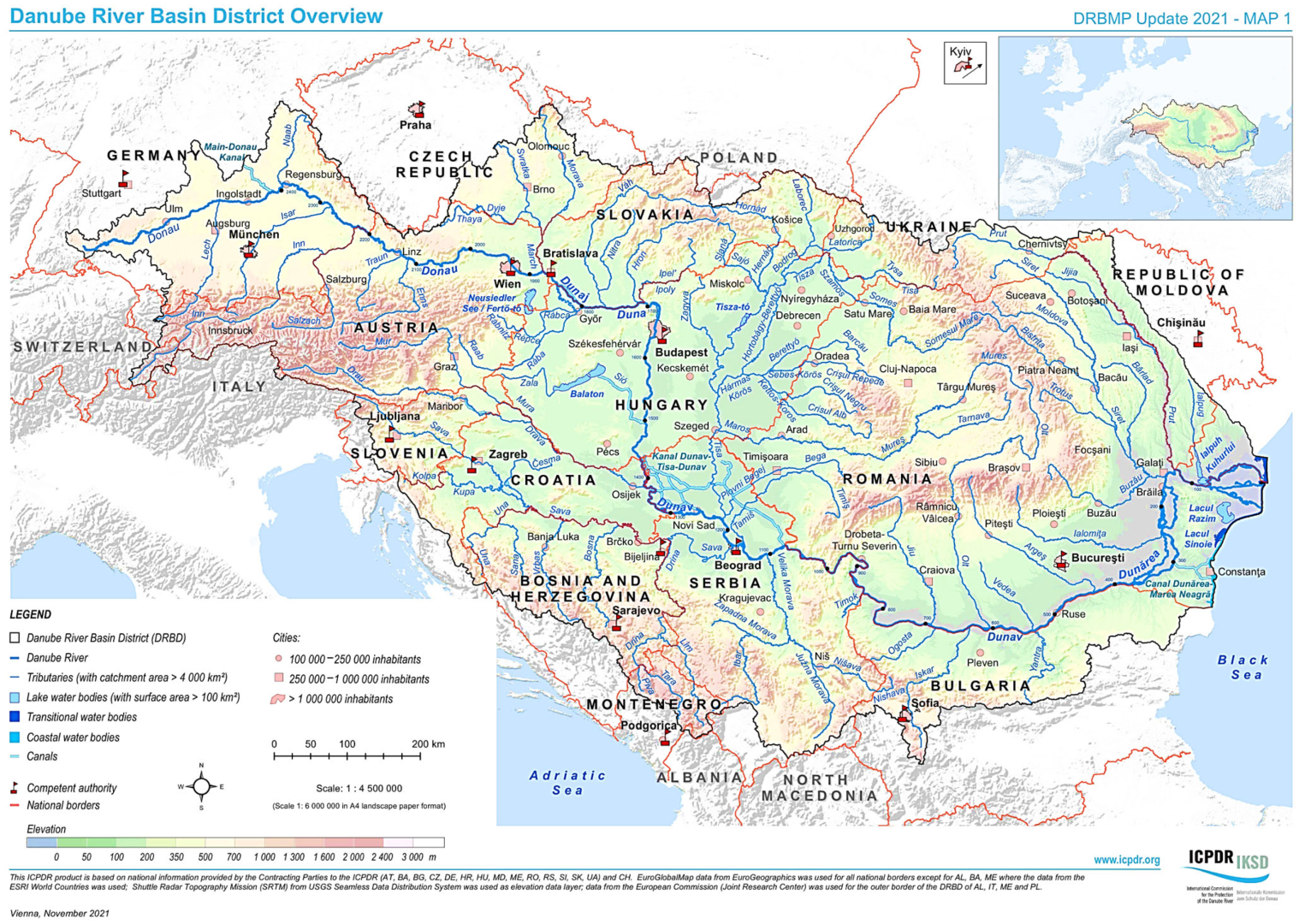
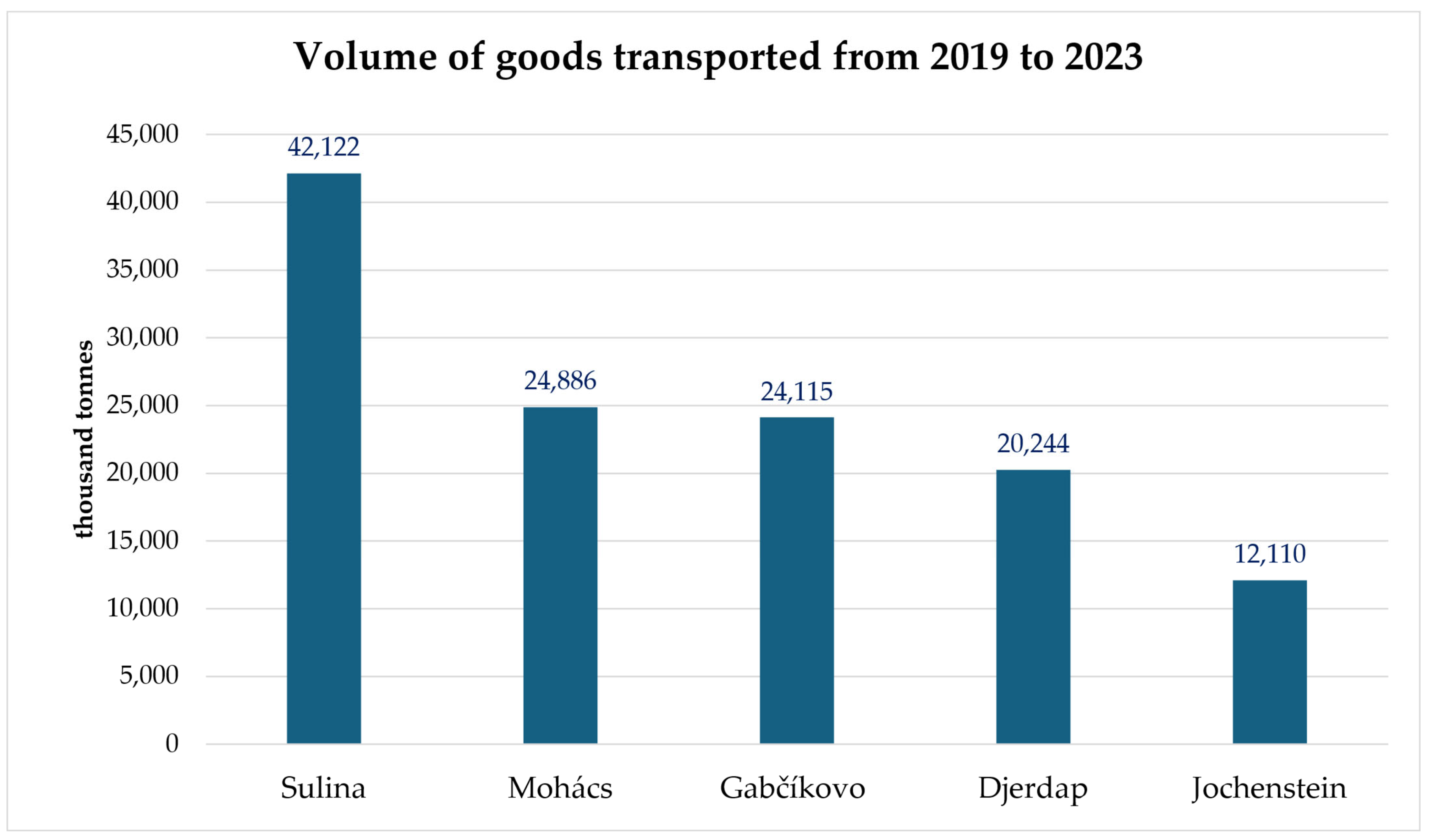
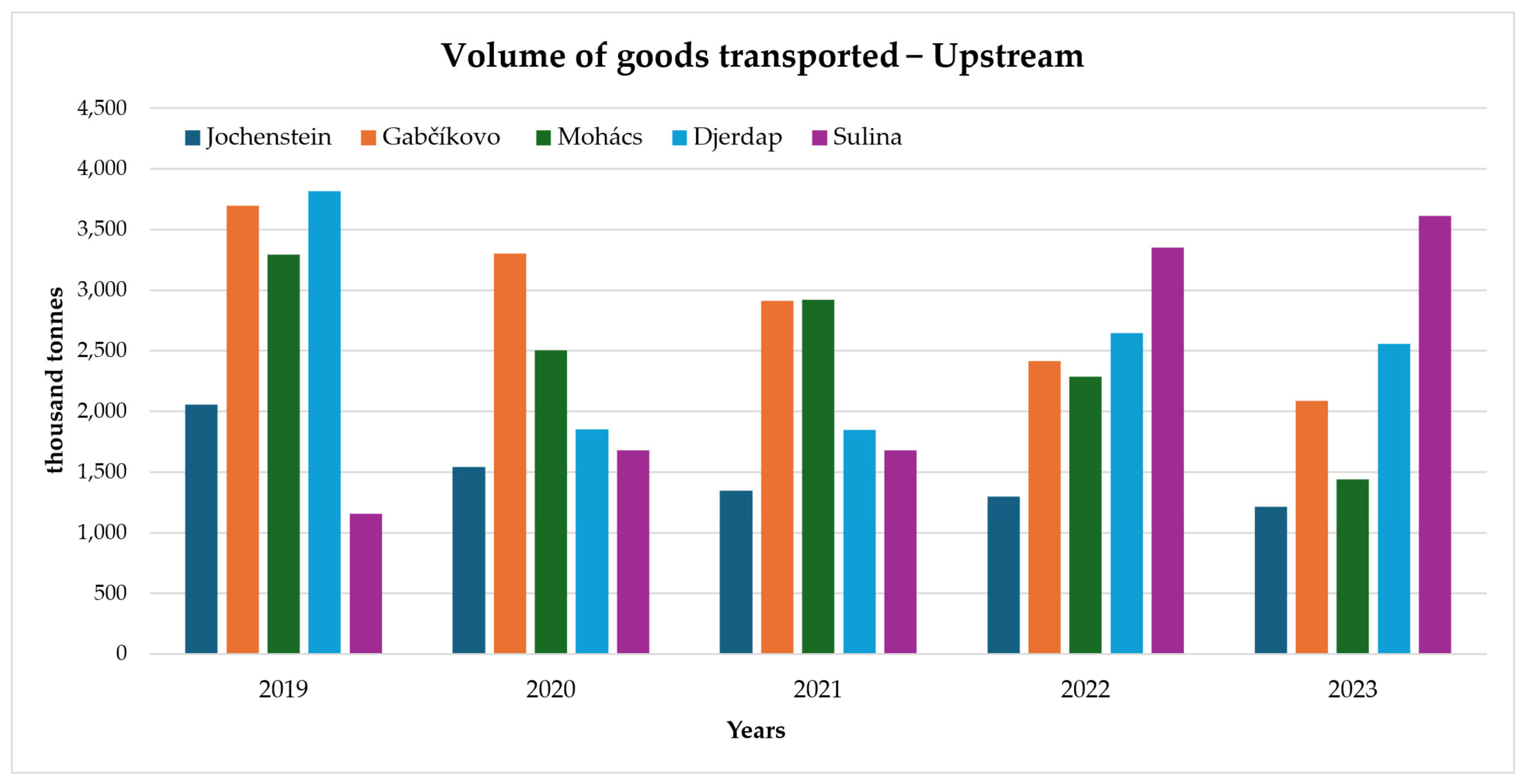
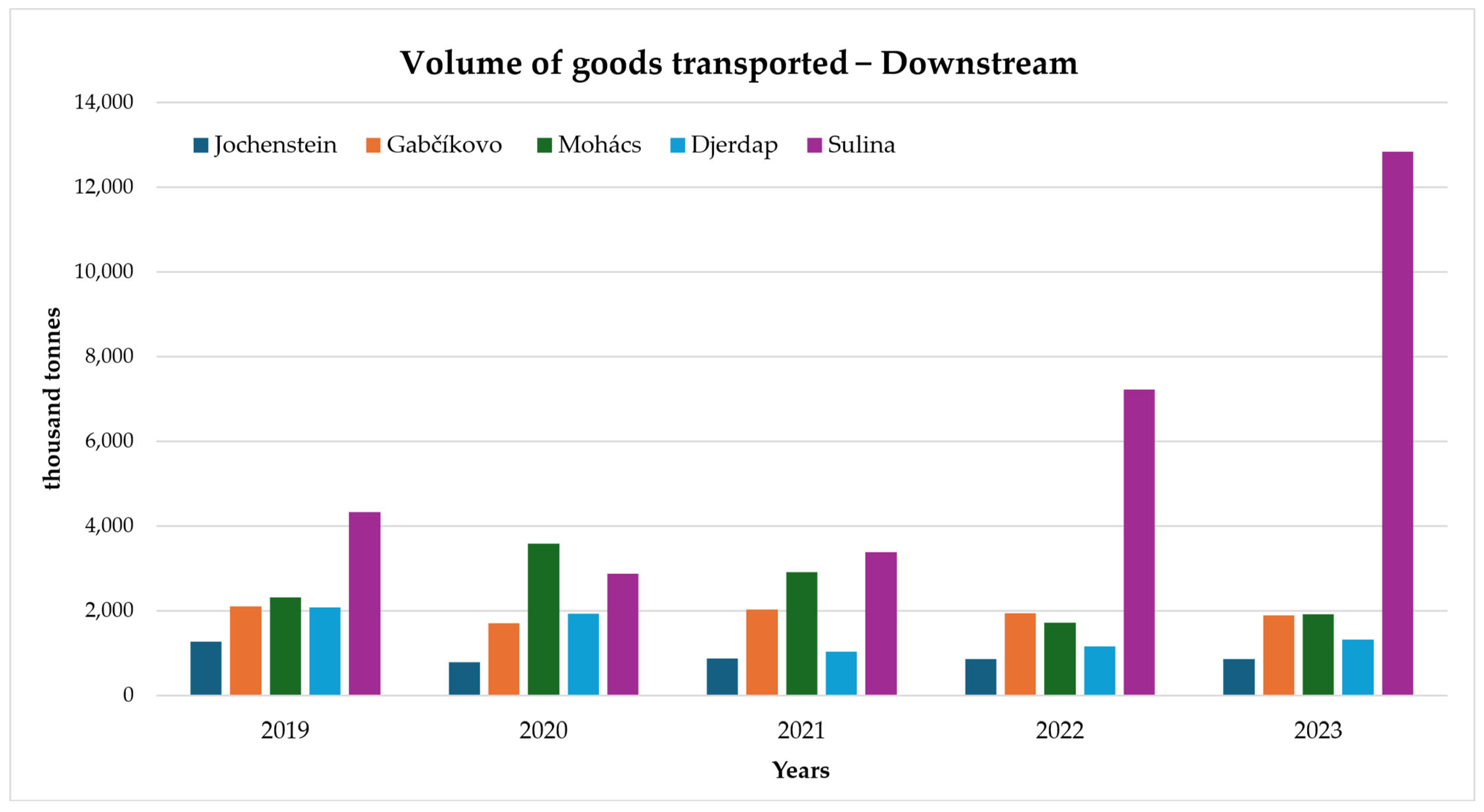
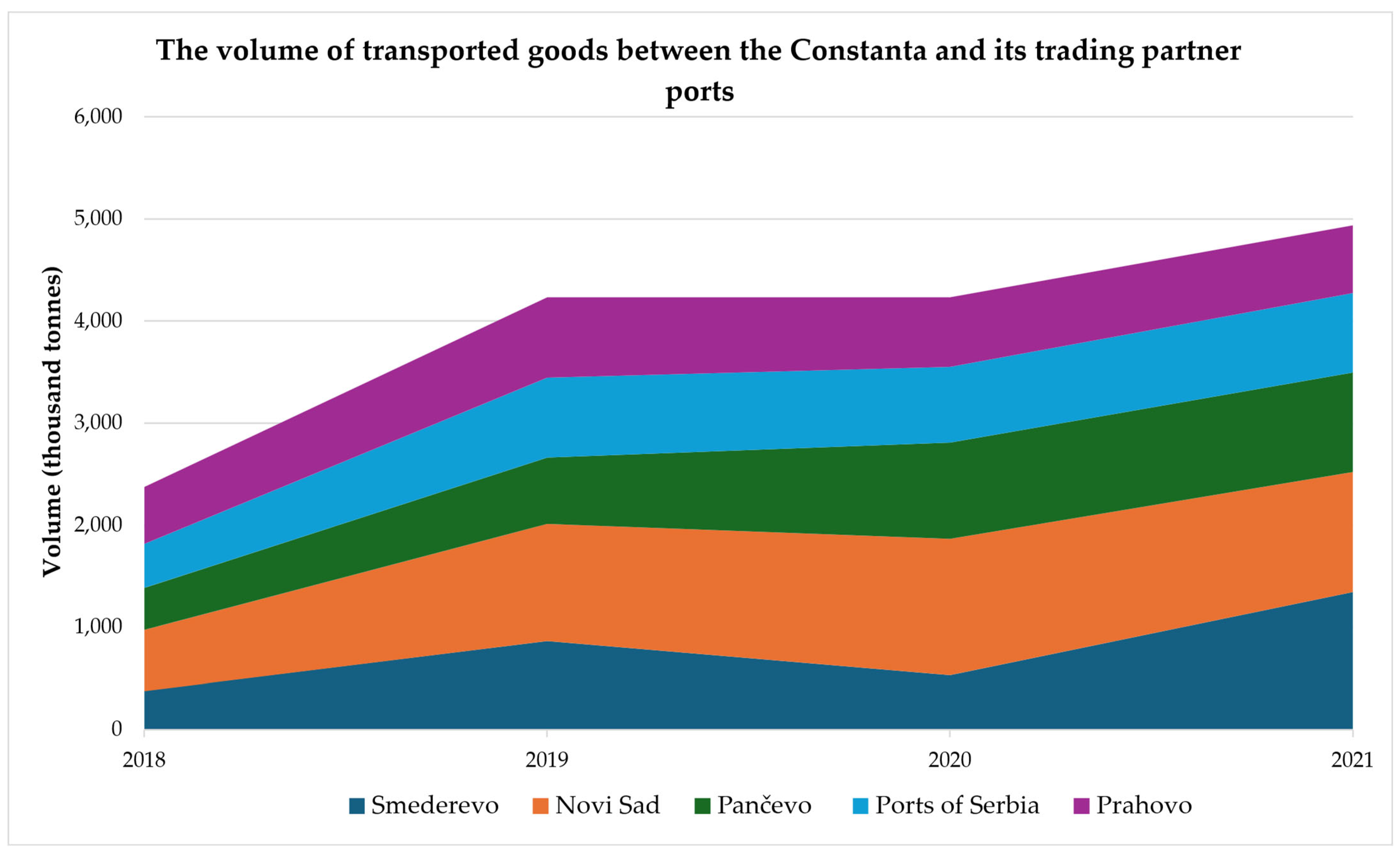
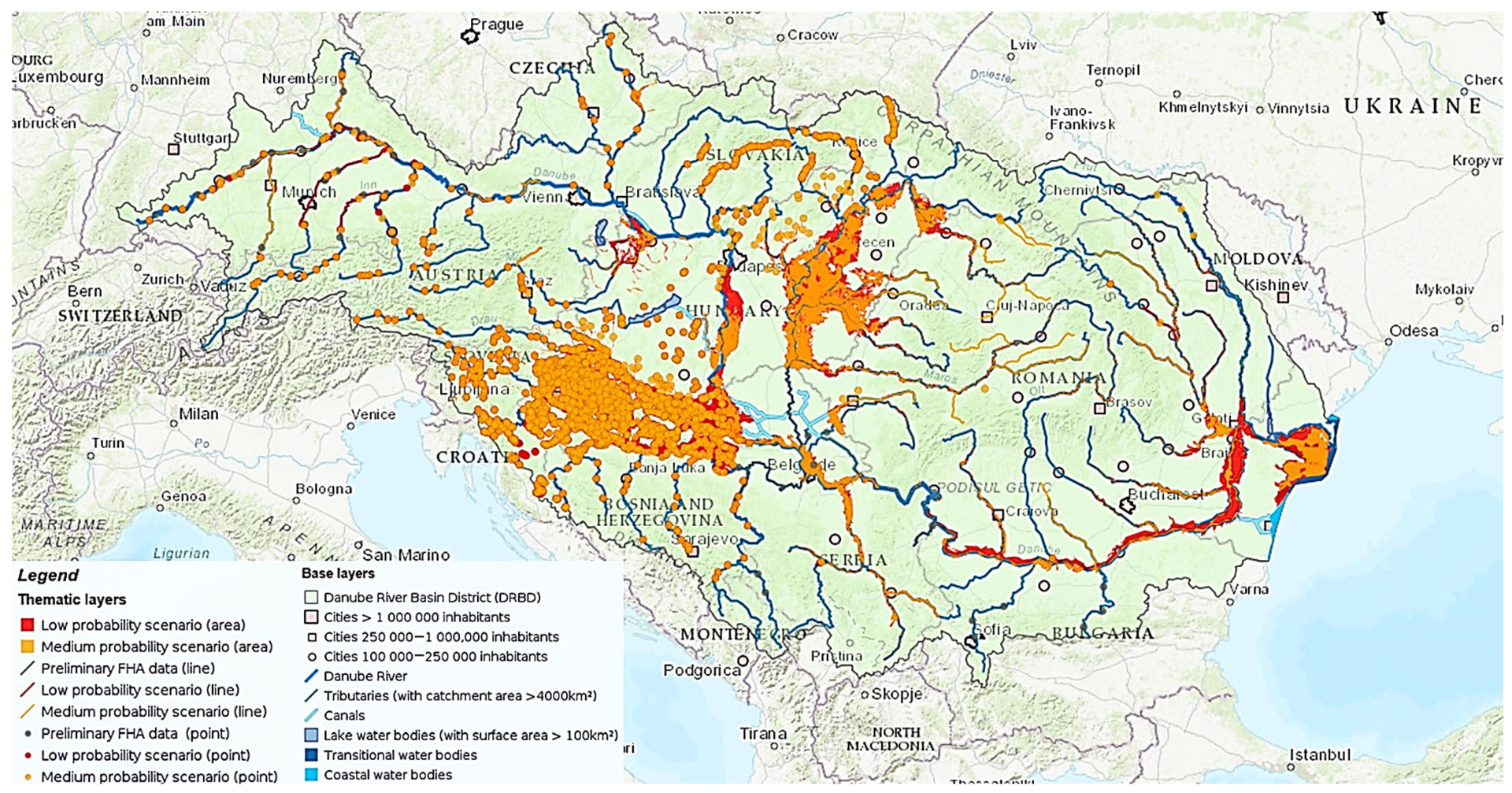
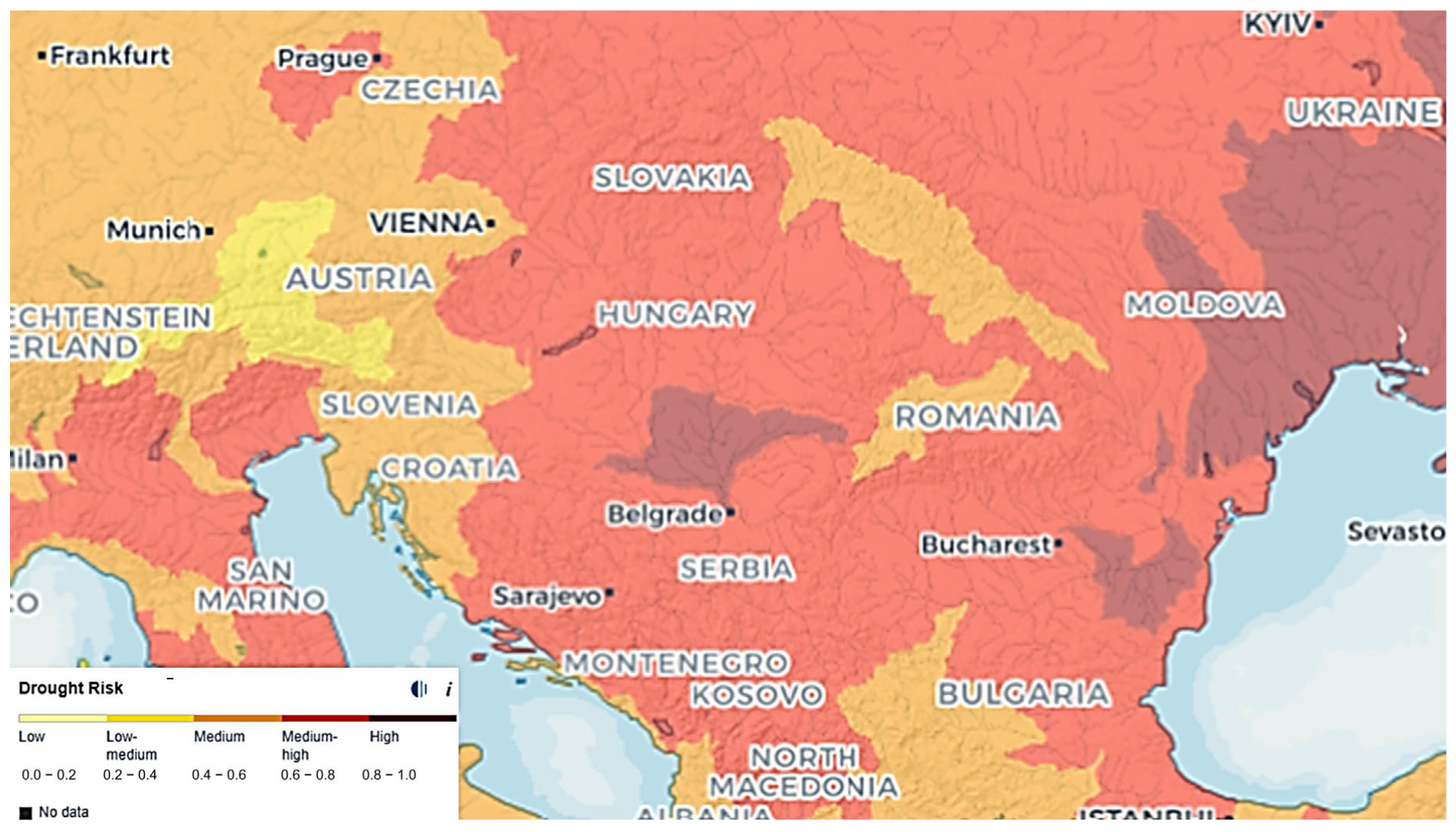
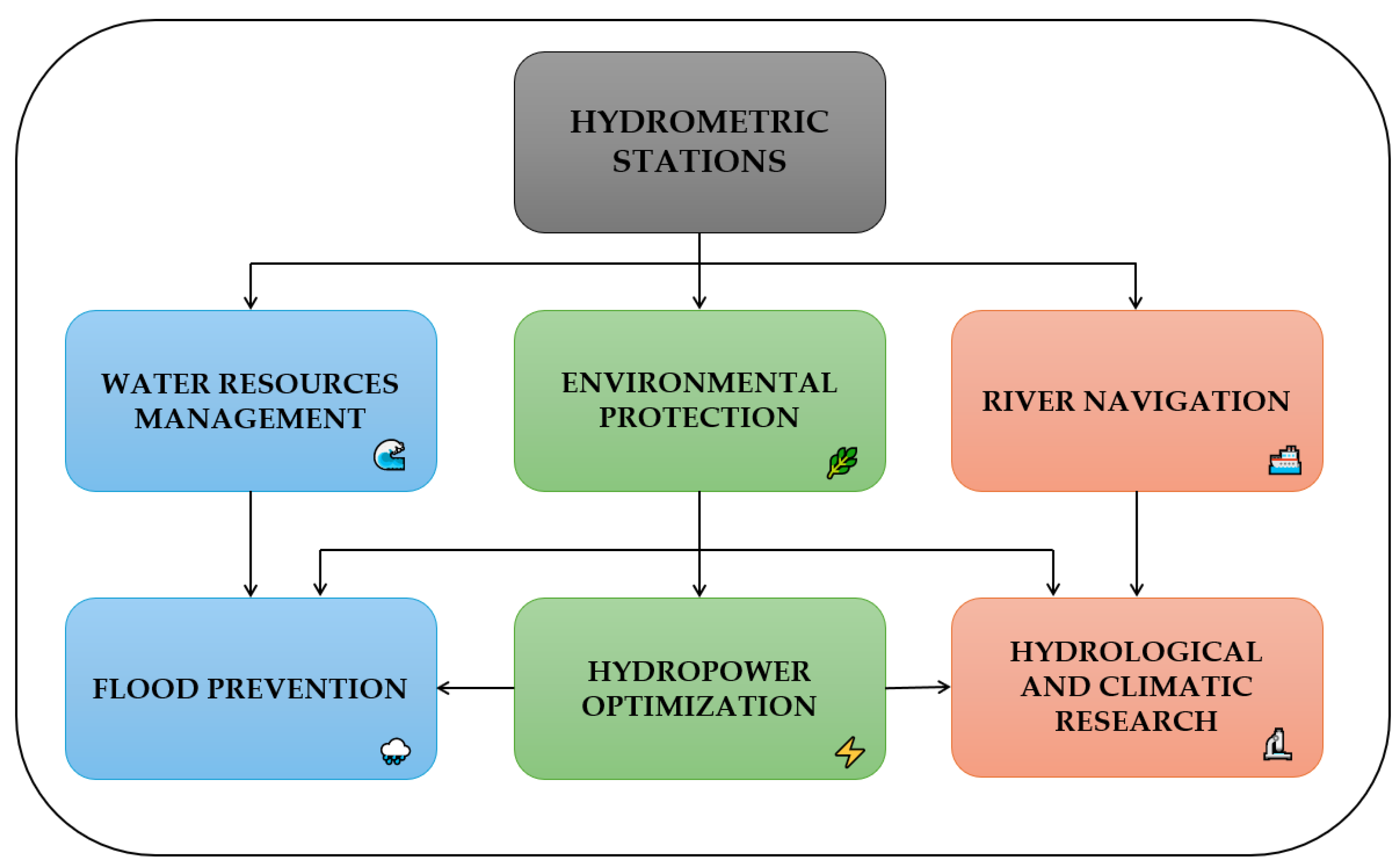
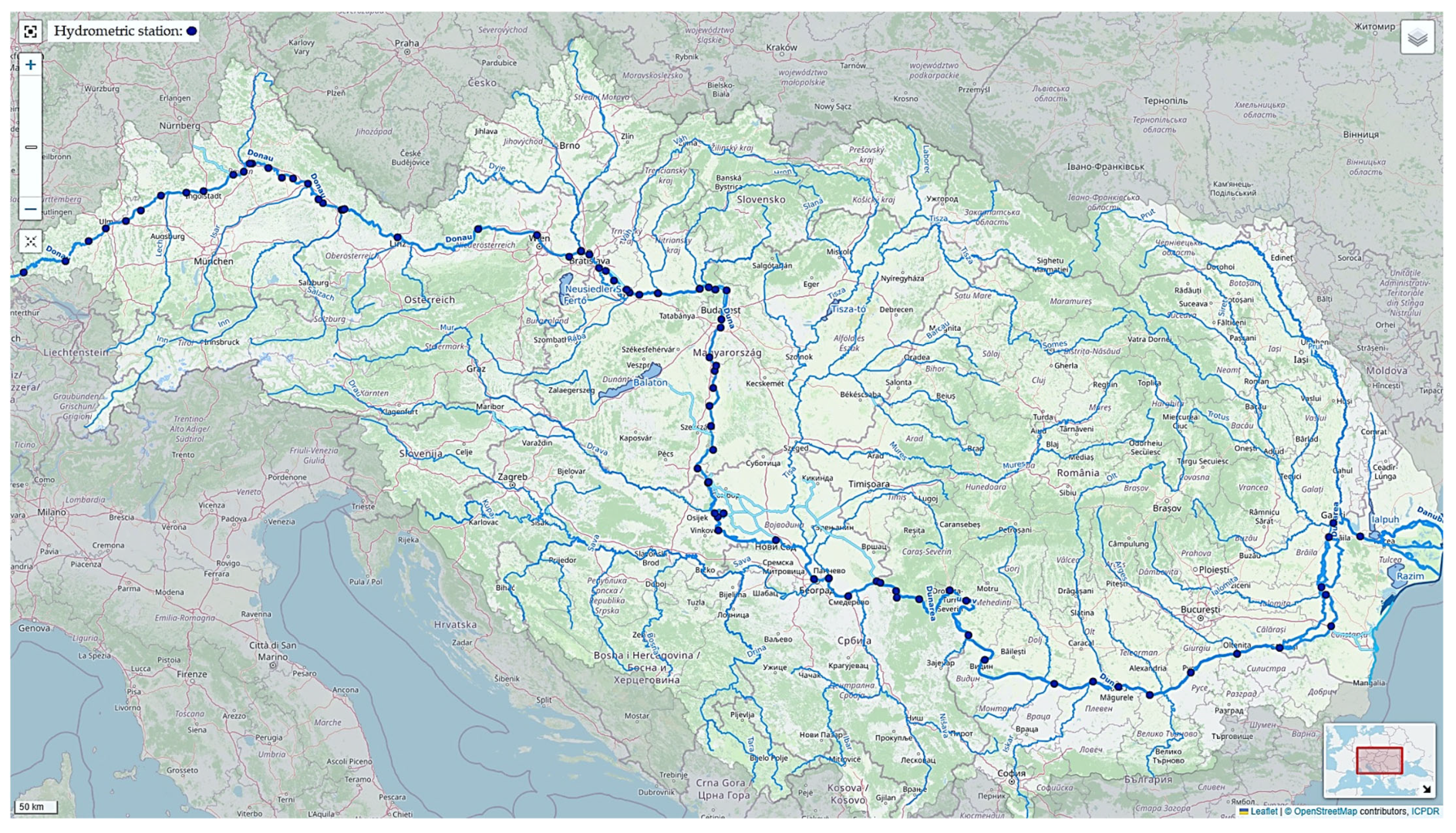
| Geographical data | Countries crossed | Germany, Austria, Slovakia, Hungary, Croatia, Serbia, Romania, Bulgaria, Moldova, Ukraine |
| Source | Germany, Black Forest Mountains | |
| Discharge | Black Sea | |
| Hydrological features | Length | About 2850 km |
| Average flow | 6.500 m3/s [39] (measured at the discharge, in the Sulina area) | |
| Major tributaries | Iller, Gunz, Mindel, Lech, Regen, Altmuhl, Isar, Inn, Enns, Morava, Leitha, Vah, Hron, Ipel, Sio, Drava, Vuka, Tisa, Sava, Timis, Velika Morava, Caras, Nera, Ponicova, Cerna, Jiu, Iskar, Olt, Vedea, Arges, Ialomita, Siret, Prut. | |
| Economic relevance | Navigation |
|
| Agriculture |
| |
| Tourism |
| |
| Biodiversity |
| |
| Hydro-energy |
|
| Tributary | Length | Countries Crossed | Discharge | Average Flow | Relevance |
|---|---|---|---|---|---|
| Inn | 517 km | Switzerland, Austria, Germany | Passau, Germany | 738 m3/s |
|
| Morava | 354 km | Czech Republic, Austria, Slovakia | Devin, Slovakia | 120 m3/s |
|
| Drava | 749 km | Hungary, Italy, Austria, Slovenia, Croatia | Osijek, Croatia | 670 m3/s |
|
| Sava | 990 km | Slovenia, Croatia, Bosnia and Herzegovina, Serbia | Belgrade, Serbia | 1564 m3/s |
|
| Tisa | 965 km | Ukraine, Romania, Slovakia, Hungary, Serbia | Titel, Serbia | 792 m3/s |
|
| Olt | 615 km | Romania | Turnu Magurele, Romania | 174 m3/s |
|
| Prut | 953 km | Ukraine, the Republic of Moldova, and Romania | Reni, Ukraine | 110 m3/s |
|
| Component | Major Geographical Areas | Drainage Area (km2) | Drainage Area Description |
|---|---|---|---|
| Upper Danube | Black Forest, Nordic Alps | ~77.000 | Mountainous areas, with steep relief, predominantly snow and rain-fed, and with a high hydropower potential. |
| Middle Danube | The Pannonian Plain | ~306.000 | Lowland and upland relief, intensive agriculture, relatively stable flow, moderate flood risk. |
| Lower Danube | Romanian Plain, Danube Plain | ~434.000 | Low-lying region with extensive alluvial meadows, high biodiversity, and a slow flow. |
| Inn | Eastern Alps | ~26.000 | Alpine tributary, increased spring flow from snowmelt. |
| Morava | Carpathian Mountains, Moravian Lowlands | ~49.800 | They form extensive, ecologically valuable wetlands. |
| Drava | South-East Alps | ~41.200 | Mixed relief and important for hydropower and local biodiversity. |
| Sava | The Dinaric Alps, Pannonian Plain | ~95.700 | A major tributary with rich flow flows through urbanized and natural areas sensitive to flooding. |
| Tisa | Carpathian Mountains, Pannonian Plain | ~157.000 | The most extensive tributary includes upland and lowland areas, affected by agriculture and industry. |
| Olt | Southern Carpathians, Getic Sub-Carpathians | ~24.000 | The mountain and the Subcarpathian region are used for hydropower and agriculture. |
| Siret | Eastern Carpathian Mountains, Moldavian Plain | ~44.800 | Eastern tributary, seasonal flow, flood, and erosion-prone areas |
| Prut | Moldovan Plateau | ~27.500 | Agricultural region, hydrographic frontier role. Variable flow, influenced by the eastern climate. |
| Rule | Description | Sector |
|---|---|---|
| Maximum speed | The maximum speed of ships on the Danube is controlled to prevent bank erosion and protect ecosystems. |
|
| Safety measures | Ships must be equipped with rescue and accident prevention equipment. Each vessel must have safety equipment (life jackets, lifeboats) following the required standards. |
|
| Cargo control | Ships must ensure a balanced distribution of cargo to avoid instability and capsizing. Vessels must respect tonnage limits and ensure even cargo distribution to prevent accidents. |
|
| Navigation in low visibility | Reduce speed and use sound signals for vessel safety. In fog conditions, vessels must use audible signals (two short beeps for “ahead” and three beeps for “stop”). |
|
| Navigation in narrow areas | In narrow sections of the Danube, vessels must reduce speed and give priority according to local regulations. Vessels meeting each other must keep to the right and communicate by sound signals to avoid collisions. |
|
| Rules for passenger ships | Ships carrying passengers must have special authorization and additional safety rules. |
|
| Priority | Vessels following the main course of the Danube have priority over those navigating on the side branches or lateral areas. |
|
| Risk/Challenge | Drivers | Environmental Impacts | Economic Impact | Measures |
|---|---|---|---|---|
| Floods |
|
|
|
|
| Droughts |
|
|
|
|
| Ice freezing and ice formations |
|
|
|
|
| Pollution |
|
|
|
|
| Riverside erosion and landslides |
|
|
|
|
| Lack of effective international cooperation |
|
|
|
|
| Risks generated by climate change |
|
|
|
|
| Year | Cause | Affected Areas | Damages |
|---|---|---|---|
| 2002 | Heavy rain and snow melt | Germany, Austria, the Czech Republic, Hungary, Romania, Slovakia | €3.6 billion |
| 2006 | Heavy rain and snow melt. | Germany, Austria, the Czech Republic, Slovakia, Hungary, Croatia, Serbia, Romania, Bulgaria, and Moldova | €600 million |
| 2010 | Heavy rainfall and fast run-off | Entire Danube basin | €2.0 billion |
| 2013 | Constant and intense rainfall | Germany, Austria, the Czech Republic, Slovakia, Hungary, Croatia, Serbia, Romania, Bulgaria | €2.4 billion |
| 2017 | Ice formation and blockages (Siberian cold air mass) | Slovakia, Hungary, Ukraine, Croatia, Serbia, Bulgaria, Romania | €3.5 million |
| Year | Duration | Cause | Affected Areas | Major Impact |
|---|---|---|---|---|
| 1947 | 2 years |
|
| The Lower Danube Basin |
| 2003 | 6 months |
|
| Germany Austria Romania |
| 2012 | 7 months |
|
| Romania Serbia Bulgaria |
| 2017 | 4 months |
|
| South-East Europe |
| 2018 | 6 months |
|
| Serbia Hungary Romania |
| 2022 | 8 months |
|
| Central and Eastern Europe |
| Organization | Area of Activity | Role | Methods | Collaborations |
|---|---|---|---|---|
| ICPDR [90] (International Commission for the Protection of the Danube River) | protection and sustainable use of Danube water resources | pollution reduction, flood prevention, and biodiversity conservation | hydrological monitoring, river basin management plans | EU, UN, Danube basin states, environmental NGOs |
| EUSDR [107] (Danube Region) | sustainable development, environmental protection, infrastructure, innovation, and cross-border cooperation | supporting the economic and social development of the Danube region through joint projects, environmental, transport, energy, education, and innovation policies. | Elaboration of integrated policies and strategies for developing, financing, and implementing projects through EU and national funds, as well as regular monitoring and reporting on the progress and impact of initiatives. | European Commission, international organizations, research institutions and universities, NGOs, and the private sector to develop sustainable solutions |
| EDO [105] (European Drought Observatory) | Drought monitoring and analysis at the EU level | providing drought data and maps to support policy and management decisions | satellite observations, drought indicators, climate models, historical analysis | European Commission, National Meteorological Centers, national and regional authorities |
| DUS [108] (Danube Drought User Service) | monitoring drought and its impact on the Danube basin | providing real-time data on drought and related risks to decision-makers | remote sensing, historical databases, impact and risk assessments | Universities, research institutes, and national governments |
| GRDC [109] Global Runoff Data Centre | collecting and providing data on global water outflow | monitoring the hydrological regime of the Danube and comparison with other river basins | global hydrological databases, forecast models | World Meteorological Organization (WMO), national governments |
| EEA [97] (European Environment Agency) | environmental protection and water quality data reporting | assessing water quality and the impact of climate change on the Danube | remote sensing, integrated water databases, assessment reports | European Commission, national environmental agencies |
| ISRBC [110] (International Sava River Basin Commission) | international cooperation in the management of the Sava River basin (tributary of the Danube) | integrated water management, environmental protection, and sustainable navigation | GIS systems, hydrological models, and water quality monitoring | Sava Basin countries, ICPDR, EU |
| DSTF [111] (Danube Sturgeon Task Force) | protection of the sturgeon species in the Danube | biodiversity conservation and recovery of sturgeon populations | ecological monitoring, restocking programs, fisheries regulations | European Commission, ICPDR, local NGOs |
| Category | Tools/Models (Examples) | Application | Features | Limitations |
|---|---|---|---|---|
| Hydrological Monitoring | Hydrometric stations, IoT multi-parameter sensors |
|
|
|
| Remote Sensing | ArcGIS, TRMM, MODIS |
|
|
|
| Topographic Analysis | LiDAR 360, Global Mapper, LiDAR drones |
|
|
|
| Hydrological Simulation Models | SWAT, HEC-HMS, MIKE SHE, LISFLOOD, HYPE |
|
|
|
| Bathymetric Surveying | Bathymetric sonar, Delft3D |
|
|
|
| Sediment Analysis | GPR (Ground Penetrating Radar), GPRSIM, HyPack |
|
|
|
| Hydraulic Flow Simulation | HEC-RAS, MIKE 11 |
|
|
|
| AI and Machine Learning Models | LSTM networks |
|
|
|
| Country | No. of Stations | Representative Stations | Main Features | Types of Equipment Used | Network Particularities |
|---|---|---|---|---|---|
| Germany | ~10 | Donaueschingen, Kehl, Neuburg | level, flow rate, high accuracy | hydrometric radar, hydrostatic pressure sensors | mountain stations, difficult access |
| Austria | ~20 | Linz, Vienna, Krems | navigation monitoring, flow control | Hydrometric radar, ADCP for currents, auxiliary weather station | monitoring dams and reservoirs |
| Slovakia | ~8 | Bratislava, Devín | flow rate, level, and weather data | ultrasonic sensors, hydrostatic pressure | automatic stations in urban areas |
| Hungary | ~15 | Budapest, Komárom, Mohács | urban monitoring, flood prevention | hydrometric radar, ADCP for currents, weather stations, automatic sampling systems | high station density, automatic stations |
| Croatia | ~10 | Vukovar, Ilok | flow rate, level | ultrasonic sensors, hydrostatic pressure | stations at key river traffic points |
| Serbia | ~20 | Belgrade, Smederevo, Prahovo | level, flow rate, | hydrometric radar, ADCP for currents, auxiliary weather stations | dense network for flood prevention |
| Bulgaria | ~15 | Ruse, Silistra, Lom | flow rate, water quality, navigation | hydrometric radar, hydrostatic pressure | combined stations with water quality equipment |
| Romania | ~25 | Baziaș, Drobeta-Turnu Severin, Brăila, Galați | level, flow rate, temperature | hydrometric radar, ADCP for currents, temperature sensors | permanent stations, real-time monitoring |
| Ukraine | ~10 | Izmail, Reni, Vilkove | level, flow rate, and water quality monitoring | hydrometric radar, automatic sampling systems | automatic and manual stations |
| Water Level Sensors | |||
|---|---|---|---|
| Radar Sensors (Non-Contact) | Ultrasonic Sensors | Hydrostatic Pressure Sensors | |
| Placed above the water, they emit radio waves that measure the distance to the water’s surface. | Similar to radar sensors, but they use sound waves. | Measures the water column pressure. | |
| They are commonly used in Austria, Germany, Romania, and Serbia due to their reliability and minimal maintenance. | They are used in Slovakia and Croatia for precise measurements, usually in protected sections. | They are placed in the water and provide continuous data. They are used extensively in Germany, Croatia, and Bulgaria. | |
| Flow and current sensors | |||
| ADCP (Acoustic Doppler Current Profiler) | Fixed or mobile flow measurement systems | ||
| It uses the Doppler effect to measure the speed of vertical currents. | Installed in navigable sections for calibration or permanently installed. | ||
| Very efficient in complex measurements and used in Austria, Hungary, Romania, and Serbia. | Present in all modern stations. | ||
| Water quality systems | |||
| Multiparametrics | Automated sampling systems | ||
| Simultaneously measures pH, dissolved oxygen, conductivity, turbidity, and temperature. | Collect water samples at regular intervals for laboratory analysis. | ||
| Use in Bulgaria, Romania, and Ukraine, especially in environmentally sensitive areas. | Common in Hungary and Ukraine. | ||
| Auxiliary equipment | |||
| Integrated weather stations | Data Logger | ||
| Measures air temperature, precipitation, wind, and solar radiation. | Data storage systems in case of loss of communication. | ||
| They are frequently integrated into hydrometric stations in Austria, Hungary, Serbia, and Romania. | Present in all modern stations. | ||
| STRENGTHS | WEAKNESSES |
|---|---|
|
|
| OPPORTUNITIES | THREATS |
|
|
Disclaimer/Publisher’s Note: The statements, opinions and data contained in all publications are solely those of the individual author(s) and contributor(s) and not of MDPI and/or the editor(s). MDPI and/or the editor(s) disclaim responsibility for any injury to people or property resulting from any ideas, methods, instructions or products referred to in the content. |
© 2025 by the authors. Licensee MDPI, Basel, Switzerland. This article is an open access article distributed under the terms and conditions of the Creative Commons Attribution (CC BY) license (https://creativecommons.org/licenses/by/4.0/).
Share and Cite
Popa, V.-I.; Rusu, E.; Chirosca, A.-M.; Arseni, M. Danube River: Hydrological Features and Risk Assessment with a Focus on Navigation and Monitoring Frameworks. Earth 2025, 6, 70. https://doi.org/10.3390/earth6030070
Popa V-I, Rusu E, Chirosca A-M, Arseni M. Danube River: Hydrological Features and Risk Assessment with a Focus on Navigation and Monitoring Frameworks. Earth. 2025; 6(3):70. https://doi.org/10.3390/earth6030070
Chicago/Turabian StylePopa, Victor-Ionut, Eugen Rusu, Ana-Maria Chirosca, and Maxim Arseni. 2025. "Danube River: Hydrological Features and Risk Assessment with a Focus on Navigation and Monitoring Frameworks" Earth 6, no. 3: 70. https://doi.org/10.3390/earth6030070
APA StylePopa, V.-I., Rusu, E., Chirosca, A.-M., & Arseni, M. (2025). Danube River: Hydrological Features and Risk Assessment with a Focus on Navigation and Monitoring Frameworks. Earth, 6(3), 70. https://doi.org/10.3390/earth6030070









